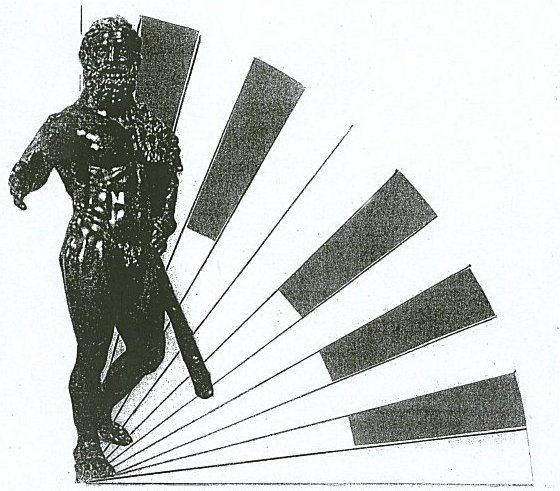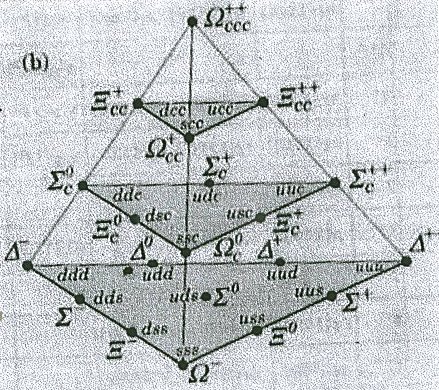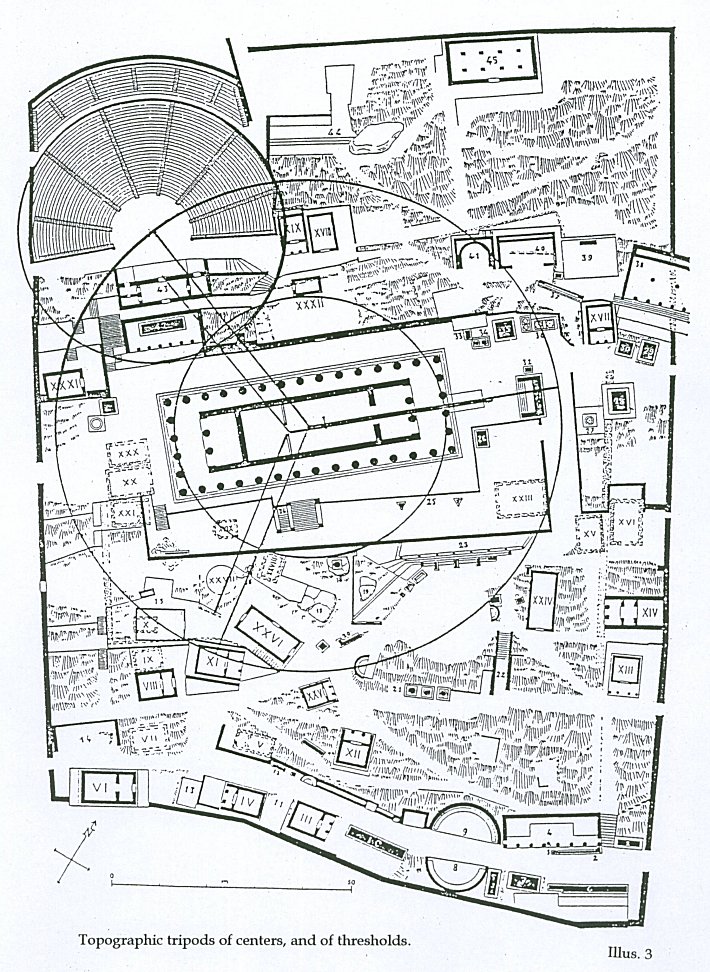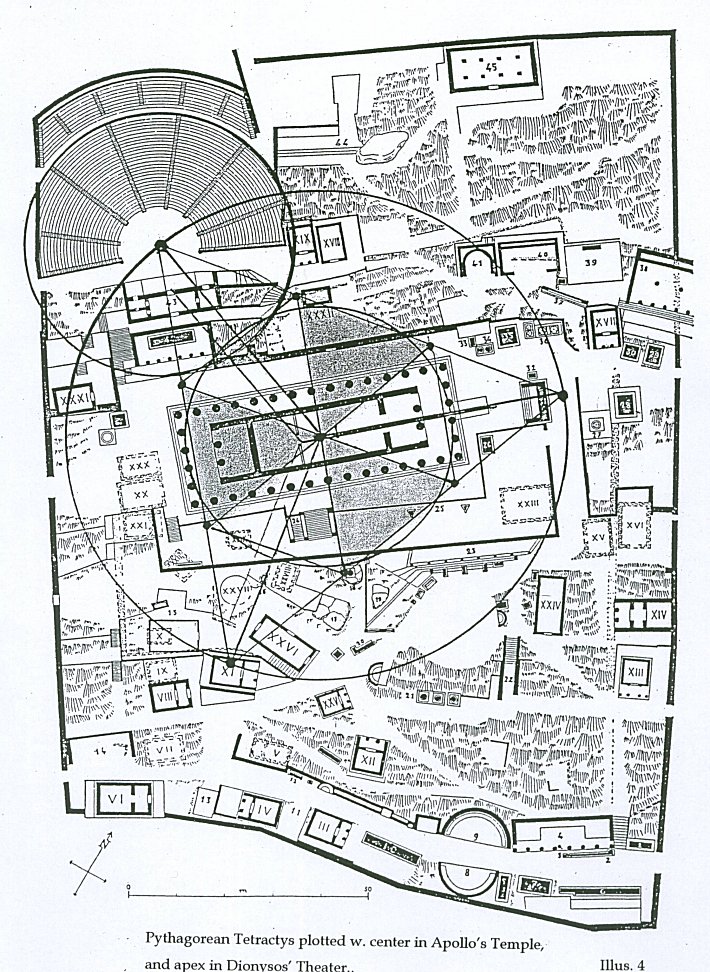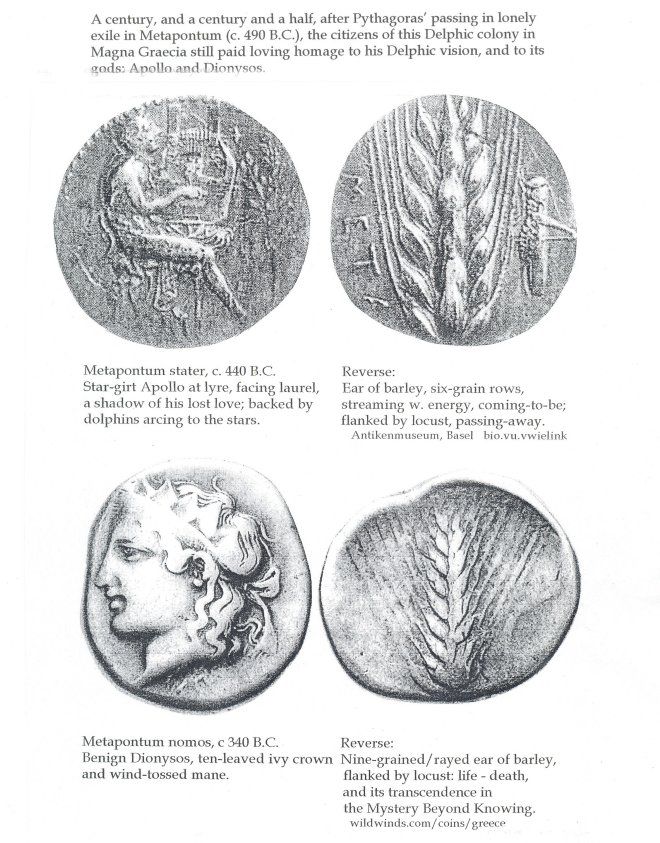The world in the 21st century faces a confrontation of monotheistic belief systems: orthodox-fundamental Judaism/Christianity vs. radical Islam.
PARANADA: BEYOND BEYOND, Beyond the Geometry of the Gods
presents a discovery of a geometric order to the sanctuary of the gods of Nature philosophy--Apollo, the god of reason, and Dionysos, the god of ecstasy--who held sway at the Hellenic birthplace of Western civilization, Delphi, a geometric order offering a spiritual resolution to this challenging confrontation.
Here, in the subtle geometry of Delphi’s plan is revealed how initiates into the Delphic mysteries sought to attain a psychic balance of the two opposing energies, of mind and body; and one offering, as well, a solution to the political strife then wracking the Greek city states, and to the religious strife which later plagued the Roman empire, in response to which challenge Emperor Julian proposed his amazingly liberal “Edict of Religious Toleration,” that included the re-establishment of Nature philosophy’s mysteries at Delphi. Edward Gibbon, in The Rise and Fall of the Roman Empire, reflecting on the proposal’s ominous failure, prophetically observed: “[Nature] philosophy alone is able to eradicate deadly fanaticism.”
The key to the discovery of Delphi’s geometric code was made possible by publication of the meticulous survey of the Delphic sanctuary by the French archeological team of Pierre de la Coste-Messeliere in 1936. It revealed Delphi was so framed it functioned as a giant zodiacal sundial that, at the vernal equinox, aligned the seemingly opposed forces of Nature--Apollonian order and Dionysian ecstasy--in a conjoined thrust transporting the spirit of Delphic initiates, ‘on’ Apollo’s “far-darting arrow,” beyond the Pole Star, and, transcendentally, beyond the source of Nature’s creation and cyclic dissolution--indeed, ‘beyond beyond,’ beyond the ‘Boundless’ apeiron.
Referring to the Delphic plan (Illus. 5), with the zodiac/clock centered in Dionysos’ theater, note the quartering of the day, and zodiacally, of the year. Observe how the winter quarter, encompassing the signs of Sagittarius, Aquarius, and Pisces, contains the Sanctuary of Dionysos (XXXI), and the Temple of Apollo. Further, note how the SE vector, the median of the winter quarter, at the spring equinox marking the end of Dionysos’ sojourn in the omphalos, precisely interconnects Delphi’s triad of goddesses:
1) Hestia, Goddess of the Hearth of the Universe (the Pythagorean 'Central Fire’ of creation) at the center of the circular orchestra,
2) Gaea, first holder of the Delphic seat, at the cleft by the Mound of Earth (xxvii) where the scapegoat (tragos) was sacrificed, and
3) Athena, the goddess of wisdom, in the Treasury of the Athenians (XI).
As final proof of the intricacy of the geometry of the Delphic site, note how the theater’s orientation has a declension from true North of 7.5 degrees (15 minutes, a quarter of an hour). That this seeming vagary in Nature’s order has a Pythagorean purpose is apparent when it is realized 7.5 degrees is the gravitational constant in physics, determining when a top, or fated hero, falls, as Hector in The Iliad (XIV, 314): “. . . spinning like a top to its last turning.” And, further, when it is realized that this selfsame 7.5 degree gravitational factor applies as well in music theory, marking each step in the 12-tone octave’s 90-degree ascent, or descent, creating the Pythagorean “harmony of the spheres.”

Our divided world needs to regain the transcendent vision revealed in PARANADA: BEYOND BEYOND, Beyond the Geometry of the Gods.

THE DELPHIC TEMENOS FUNCTIONS AS A GIANT SUNDIAL
Delphi is a giant sundial (See illus. 5) marking, at the spring equinox, the hourly rise of the sun (Apollo) from sunrise to high noon, countering the course of the tragic hero’s fall in the trilogy.
The pivotal point of the sundial/clock is the sacred Central Fire--the source of existence--on the altar of Hestia, hearth goddess of the universe.
In this vast time frame, the sundial has cosmic significance, marking the rise-and-fall-and-rise-and . . . of all existents--in the eternal beginningless-endless cyclic round of non-existence/existence/. . . .
Such a metaphysical conception of the rhythm of Nature at Delphi is contrary to the prevalent worldview of Delphi as home to the god of order, of limit, Apollo. As we are instructed: “Did not Delphi have inscribed above its temple portal the stern injunction, “Know the limit [of ‘thyself’]”?”
Yet Delphi is also, for the winter quarter, home to the god who came from the East, from Asia--Dionysos: striking counter force to Apollo’s “limit”; Dionysos: god of ecstatic release from the bonds (‘limits’) of Being.
Such release from Being is the basic tenet of the vedic Creation Hymn, X.129:
Then was neither Being nor Non-being. . . .
The breathless breathed breathlessly. . . .
This was before the gods. . . .
This marked the birth of abstract thought, of philosophy. It is hard to understand why Rig Veda X. 129 is not widely known. Or, perhaps, it is not, beginning as it does with a rejection of both “Non-being,” and “Being”; beginning with an implication of what, to the rationally minded, is unthinkable: the Mystery, ineffable, inconceivable--beyond human comprehension.
PARANADA’s main contention, backed by geometric and numeric Pythagorean proofs in the Delphic site and its mystic Trieteric rites, is that Delphi’s mysteries were ineffable, transcendent.
That Romantic-idealistic sensibilities are sensitive to transcendent energies emanating from Delphi’s cosmic center is evidenced by Emerson’s euphoric response to Delphi’s sacred precincts, he having remarked in his Essays on “. . . the wondrous foundations of the Temple of Apollo. . . . “
PARANADA proposes the incontrovertible presence of an intricate geometric schema at Delphi makes a compelling case for the reinstitution of transcendent mystery rites at Delphi. In honor of the sublime tragic poet, Sophocles, it proposes the annual performance, in the Delphic Theater of Dionysos, the profound mystery drama, Oedipus at Colonus.
On experiencing this rite-of-eternal-return, we, recovering our lost roots in Nature, might once again experience the exultant Mystery--beyond space and beyond time: The Mystery--beyond the geometry of the gods.
Heracles, hero of the Twelve Labors, on Nature’s Wheel of Transcendence
Roman bronze, the Louvre
The final piece in Delphi’s cosmIc MOSAIC
The wave breaks. The hero falls.
The “spark of celestial fire” flares. The spirit soars.
Here, the downward glissando on the seven strings of Apollo’s lyre, marks the octave fall through the 12-tone scale; each tone, the 7.5 degree “gravitational symmetry limit” (per D. White, “Music Scale Theory” Skytopia.com/project/scale); it, the angle at which a spinning top falls, as “noble Hector, . . . spinning like a top to its last turning.” (The Iliad, XIV, 413). And, as the greatest hero, proud Heracles, founder of Tarentum, was to fall. Could it be mere happenstance the two locations at which, legend has it (Arist. fr. 191), in a miraculous “bilocation,” Pythagoras had been simultaneously seen, he sought, before his lonely death in exile in Metapontum, refuge in Heracles’ Tarentum?
In the perennial philosophy of Nature, this gravitational descending glissando of all that exists symbolizes the stark imperative of Anaximander’s fragment: “All must pay restitution for its existence according to the dictates of Time.”
Yet, (per Hans Kayser, Akroasis, The Theory of World Harmonies, Boston, 1970), with “the note not heard” in the music of the spheres, the 13th overtonal note completing the octave, the spirit mystically attains the apex of the sacred Tetractys; and, in the Trieteric rite, the winnowed seed of infant Dionysos falls to the womb of Gaea, there, mystically, to strike fire on the altar of Hestia, “Hearth of the Universe.” Then, in the mystery-beyond-knowing, the spirit of the initiate gains release from the wheel of Being, vaulting -- beyond the Pole Star-- ‘into’ the Boundless apeiron, ‘in’ the Mystery--transcendent.
A PYTHAGOREAN-LIKE TETRACTYL LEAP INTO THE MICROCOS--FROM THE APEX OF CERN’S 3-D TETRACTYS
The Pythagoreans’ sacred Tetractys was the key to the spirit’s release from the bonds of earth ‘into,’ and beyond, the cosmos. Its apex, in the center of the theater of Dionysos’ orchestra, constituted a heavenly launch pad aimed at, and beyond, its target, the stationary Pole Star’s bulls-eye at the ‘dead’ center of the celestial whirl. It symbolized the promise of ‘life’ after death, the rebirth of the spirit from the womb of worldly care in its journey of eternal return, its deliverance from the mortal bonds of earth in its fated journey ‘into,’ and beyond, the “Boundless” apeiron.
Late in researches into the mystery of spiritual renewal in Nature, while surfing the internet in such a quest, imagine my utter amazement when--in searching the site of the University of Pittsburgh’s Physics Department, my article, “The Symmetry of Delphi” having appeared back in 1971 in the journal (Theatre Survey) then having its editorial office there--lo and behold!--there, on the small screen at fafnir,pitt,edu/particles, loomed an image of--the Tetractys! And, more remarkable still, it was not the planar 2-D Tetractys with which we’re familiar. It was in 3-D! It was not the earth-bound planar diagram that conventionally plots the ten Pythagorean tetractyl points. It was a tetrahedron, the first ‘solid’ form, with Pythagoras’ ten spheres/planets as its base, and with its apex an Apollonian arrow thrusting ‘into’ (and beyond!) space.
And there was further wonder beyond its form--its context. Its thrust was not ‘out’ toward--and beyond--the stars; its thrust, rather, was ‘in,’ toward the subatomic zero-point, toward the unfathomable mystery. For it was a diagram of the quest for the secret(s) of the microcosm, the secret of life itself!
And the legend beneath the diagram posted by Prof. E. Swanson for APS (the American Physical Society’s Topical Group: Hadronic Physics), and its article, “Constructing the Universe: the Particle Explosion,” gave the human context for its abstract form.
It was the slide image projected on the screen for attendees at the international meeting of CERN in 1962.
Its description: The lowest plane in the figure is of particular interest. At the meeting of CERN in 1962 the cascade (Greek letter xi) was announced. Gell-Mann and Ne’eman were both in the audience and both realized that the lower plane was being filled out according to their expectations--only the last particle, the omega, was missing. Both raised their hands and Gell-Mann was called upon. He strode to the front and announced that a new particle must exist which he called the omega. Two years later it was discovered at Brookhaven . . .
At this, the spirit of Pythagoras might have nodded approvingly? Or shaken disapprovingly: to have his most sacrosanct icon thus exposed to those not apprised of its arcane significance. Might he not feel the perpetrators of such a revelation of the sacred schema, on which the brotherhood swore its most solemn oath of secrecy, must pay the ultimate price for such an indiscretion.
Is modern science tempting fate?
Or, alternatively, and hopefully, might not such a visionary insight as the sacred symbol inspires guide modern science in its probing for the mystery-of-it-all--and for the mystery-beyond-the-One? And beyond the None?
PARANADA: B E Y O N D BEYOND, Beyond the Geometry of the Gods’ purpose is to recover for our troubled times the mystery of Nature philosophers Anaximander and Pythagoras, their cosmic vision--a vision which inspired Greece’s Classic Age of high tragic greatness.
PARANADA’S superscript :
The most beautiful thing we can experience is the mysterious. Albert Einstein
Its inspiration, the call of the director of Fermilab’s cyclotron, Leon Lederman:
When will a new Einstein, in a flash of insight, give us back our lovely nothingness?
--an ecstatic vision Emerson was privileged in his essay, “Nature”) to share, on visiting Delphi, he then being moved to remark on
“. . . the wondrous foundations of the Temple of Apollo . . .”:
Currents Universal circulate through me.. . . . All mean egotism vanishes. . . . Natura naturans .publishes itself . . . through transformation on transformation to the highest symmetries. . . . All changes pass without violence by means of two cardinal conditions of boundless space and boundless time.
DEATH, AND TRANSCENDENT REBIRTH, AT TARENTUM
PARANADA: B e y o n d Beyond traces a long journey of discovery, and recovery, the recovering of a lost vision, the vision of what I humbly believe to have been the greatest mind the world has known--Pythagoras’.
When he faced death in lonely exile in Metapontum, across the Gulf of Taranto from Tarentum, which the preeminent Greek hero, Heracles, (who once sought to wrest the Delphic tripod from Apollo) had founded, he might well have stood on its heights overlooking the waters of the gulf sparkling to the distant horizon in the dancing light of the sun, the sun of his god, Apollo. And it is not too much to imagine he might then have watched at sunset, with an aching heart, a merchant ship recede in the distance over the horizon, a ship heavy-laden with Metapontum’s annual offering of grain from its rich harvest, the harvest of Dionysos; a loving gift to the Delphic oracle, to the sacred site he, Pythagoras (and, per Homer, some mysterious power!), had so subtly crafted to mirror the celestial order soon to scintillate in the night sky.
This has been a long journey--and a sad one, one marked by a deep sense of loss. For the world, in its embrace of material substantiality, worldly matter and matters, of things you can touch, and hold in your hand, has been seemingly oblivious to Pythagoras’ searing vision of an unbounded, transcendent cosmos of ever-renewing energies.
Yet, it is the hope of this assay on the unapproachable mystery that the world might awaken to Pythagoras’ dream and ‘see’ that for which his soul ached--“the eternal return,” the return to the point-beyond-knowing, the great Beyond, beyond-sensing.
Yes, the world has seemingly forgotten Pythagoras’ paracosmic desideratum. Or -- in its deepest deep -- has it? -- Have we?!
For are not we all -- Oedipus?
Delphi is a place of mystery confounding logic: a cosmic ‘center’ of the “Boundless,” which has no center, as in the mystic gnosis of Cusanus (Cardinal Nicholas of Cusa) who envisioned a circle whose center is “everywhere,” and periphery, “nowhere.”
In this light, Delphi is “everywhere,” and “nowhere”; all of teeming Nature: its creation, its dissolution, and its miraculous renascence.
Delphi, in sum, encapsulates the Mystery, the deepest Mystery.
And, coming full circle to the superscript with which we began:
The most beautiful thing we can experience is the mysterious. Albert Einstein
PREFACE:
You will note at the very bottom of the cover--
PARANADA:
B E Y O N D
B E Y O N D,
B E Y O N D T H E G E O M E T R Y
O F T H E G O D S
(at the ‘center’ of the cosmos)
D E L P H
“Antiquity’s Best-Kept Secret.”
the tagline:
DECIPHERING DELPHI
BREAKING THE PYTHAGOREAN CODE.
This latter has been the working title of the work for the past several years of its slow accretion of the hidden wisdom at Delphi..
Dealing, as I came to realize, with a breakthrough discovery of the long-lost secret code of the Pythagoreans, “Antiquity’s best-kept secret,” I thought why not, as would any Malibu surfer, “ride the wave” of code-breaking mania, as in the case of the runaway best-seller, The Da Vinci Code.
Why not?! indeed, as Dayton Allen used to officiously intone on the old Steve Allen Show.
But, money-isn’t-everything (I keep trying to tell myself). A still small voice sounded within, creating a rankling sense of unease. Finally, I looked myself in the mirror and realized this was not what it was all about. ‘Code breaking’ relates to the work’s process. “Consciousness-transforming” was where it was really at--its essence.
The main theme of the work is not Pythagoras’ involvement in the geometric symmetry of Delphi’s layout, but the philosophic principle--of transcendence, the ‘Eastern’/Asian/Indian/vedic transcendence encapsulated in the Sk. term, moksha, transcendence, which, it is the work’s main thesis, stands as a symbol of Pythagorean/Anaximandrian spiritual release ‘into,’ and “beyond” the “Boundless” apeiron.
For, it then came to me: the transcendent state beyond Being, beyond Non-Being, in effect-- ‘Beyond Beyond’ was what the work was all about.
But, as a title, “Beyond Beyond” just didn’t cut it; lacked focus.
There the matter stood for many a sleepless night: what might its focus be?-- the one word you could put up on a billboard and people would glom onto?
Then, the answer came--would-you-believe?-- aetherically on the internet (that vast sea of information, and often deep mine of insight) on the sites: experiencefestival.com/nada, “A Wisdom Archive in Nada,” and eomega.org, Omega Institute for Holistic Studies. There, on the small screen, it all came into sharp focus. For there, in the Hinduism Dictionary was the listing of the vedic term, ‘Paranada,’ and a note on the word’s usage, citing: Mme. Helena Petrovna Blavatsky’s visionary Theosophical work, Paranada: The Voice of Silence (1889):
Paranada: . . . the soundless sound, the first vibration from which = creation emanates . . .
With this realization, suddenly the finding at Delphi of a gravitational deflection of 7.5 degrees in the orientation of Apollo’s temple and Dionysos’ theater (one-twelfth a 90-degree fall, as of all physical objects from vertical to horizontal, and of the frequency of “the sound not heard” completing the 12-tone scale’s octave) nailed it! This remarkable numeric key to the complexity of visual-aural experiencee could only be the product of the subtle mind of the founder of Nature philosophy, (Gk.: philo- love of, -sophia, wisdom,) the product of the genius who first conceived the term and its profound implications--the genius of Pythagoras.
So, Paranada it is: beyond “. . . the soundless sound from which creation emanates”; b e y o n d beyond.
That the term has gained idiomatic status, as in the catch-phrase, “zip, zero, nada,” and that it brought Sartrean “Nausea” to those who lived (if-you-call-that-living) through the “alienation” of the existential Fifties, which had its roots in the dyspeptic intellectual ferment of Paris in the Roaring Twenties, and in the Threadbare (and Elegant--Rogers and Astaire!) Thirties, as in Ernest Hemingway’s astringent-yet-grungy “A Clean, Well Lighted Place” (1933); and that it resonates refractively still in shaggy Sixties’ “flower children” now heading toward retirement, as in Simon and Garfunkel’s stab of neon,“The Sound of Silence” (1964); well, these stand (or lean precariously) as grim reminders of how far we’ve fallen since Pythagoras conceived his utopian society of brothers (and sisters, “sexism” not being in Pythagoras’ playbook--he, a man well ahead of, and/or beyond his or any other time), goes without saying.
In our present parlous times, we well might ask: “Has his time finally come?”
A century and a half ago, transcendentalism swept the nation. It didn’t take; socio-political ferment swept it away.
In the ferment of today’s world of faith-based terrorism-and-counter-terrorism, don’t we desperately need what George Bush, Sr., striving to raise the political dialogue a notch or two, called “the vision thing”?
Well, “the vision thing”--it’s there waiting for us in the Pythagorean symmetry of Delphi and its celestial “music of the spheres”--there, ‘in’ its soundless-sound of the “breathing” of creation-and-dissolution-and . . ., ‘in’ the “Boundless” mystery--of Paranada.
Hec Currie, Ph.D.
Prof. Emeritus, University of Cincinnati, c. 2005
Acknowledgement: for invaluable assistance in research to Andrew Hissett, Librarian, Hamilton County Public Library, Cincinnati, OH.
Credits:
Cover, night scene of Delphi, C. Doxiadis, Architectural Space in Ancient Greece, MIT Press, 1972



